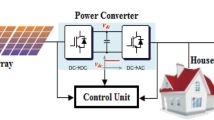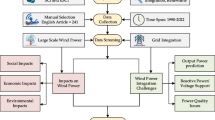Abstract
Traditional methods used for the analysis and design of power systems, like power flow studies (PFS), do not consider any uncertainties. For example, when there is a high penetration of wind power plants (WPPs), whose raw material is intermittent. In this paper is proposed a graphical probabilistic representation (GPR) based on multi-objective performance index (MPI) to assess the impact of the WPPs penetration in power systems. This representation is applied to the southeastern network of Mexico, where there is increasing penetration of WPPs. Besides, a comparative study is presented, with and without a static var compensator (SVC) device connected to the mentioned network, to evaluate the effects of shunt compensation in the point of common coupling (PCC) with WPPs. The results of this comparison are discussed using the GPR proposed. The results show that GPR can be utilized as a useful tool to represent a considerable amount of information in a clear, compact, and single visual representation.









Similar content being viewed by others
References
Adefarati T, Bansal RC (2016) Integration of renewable distributed generators into the distribution system: a review. IET Renew Power Gen 10:873–884
Ssekulima EB, Anwar MB, Hinai A, Moursi M (2016) Wind speed and solar irradiance forecasting techniques for enhanced renewable energy integration with the grid: a review. IET Renew Power Gen 10:885–989
Claudia M, Martínez M, Peña R (2014) Scenarios for a hierarchical assessment of the global sustainability of electric power plants in México. Renew Sustain Energy Rev 33:154–160
Ackermann T (2005) Wind power in power systems. Wiley, USA
Saberian A, Farzan P, Nejad MF, Hizam H, Gomes C, Othman MLB, Mohd Radzi MA, Ab Kadir MZA (2013) Role of FACTS devices in improving penetration of renewable energy. In: 2013 IEEE 7th International Power Engineering and Optimization Conference, pp 432–437
El-Shimy M, Badr MAL, Rassem OM (2008) Impact of large scale wind power on power system stability. In: 12th International Middle East Power System Conference, MEPCON 2008, pp 630–636
Slootweg J, Kling W (2003) Aggregated modelling of wind parks in power system dynamics simulations, Power Tech Conference Proceedings, Bologna, Italy
Saadat H (2010) Power system analysis. McGraw-Hill, USA
Papaefthymiou G, Schavemaker P, Sluis L, Kling W et al (2006) Integration of stochastic generation in power systems. Elsevier, Netherlands, pp 655–667
Yürüen NY, Melero JJ (2016) Probability density function selection based on the characteristic of wind speed data. J Phys.: Conf Ser 763:1–10
Ochoa L, Padilha-Feltrin A, Harrison G (2006) Evaluating distributed generation impacts with a multiobjective index. IEEE Trans Power Deliv 21:1452–1458
Cableados Industriales (2010) Parque eólico Bii Nee Stipa II, Comisión Federal de Electricidad, México
Gonzalez M, Rueda L (2014) PowerFactory applications for power system analysis. Springer, Berlin
DIgSILENT (2018) https://www.digsilent.de. Accessed 23 Oct 2018
He P, Wen F, Ledwich G, Xue Y (2016) An investigation on interarea mode oscillations of interconnected power systems with integrated wind farms. Electric Power Syst Res 78:148–157
Beltran O, Peña R, Segundo J, Esparza A et al (2018) Inertia estimation of wind power plants based on the swing equation and phasor measurement units. Appl Sci MDPI 12:1–16
Beltran-Valle O, Peña-Gallardo R, Segundo-Ramirez J, Muljadi E (2016) A comparative study of the application of FACTS devices in wind power plants of the southeast area of the Mexican electric system. In: 2016 IEEE International Autumn Meeting on Power, Electronics and Computing, pp 1–6
Chen P, Chen Z, Bak-Jensen B (2008) Probabilistic load flow: a review, electric utility deregulation and restructuring and power technologies. In: 2008 Third International Conference on Electric Utility Deregulation and Restructuring and Power Technologies, pp 1586–1591
Leite da Silva A, Ribeiro S, Arienti V, Allan R et al (1990) Probabilistic load flow techniques applied to power system expansion planning. IEEE Trans Power Syst 5:1047–1053
Jorgensen P, Christensen J, Tande J (1998) Probabilistic load flow calculation using Monte Carlo techniques for distribution network with wind turbines. Proceedings of 8th international conference on harmonics and quality of power, 2, pp 1146–1151
Leite da Silva A, Arienti V (1990) Probabilistic load flow by a multilinear simulation algorithm. IEE Proc C Gen Transm Distrib 137:276–282
Ahadi A, Reza S, Liang X (2017) Probabilistic reliability evaluation for power systems with high penetration of renewable power generation. 2017 IEEE international conference on industrial technology (ICIT), pp 464–468
Sulaeman S, Alharbi F T, Benidris M, Mitra J (2017) A new method to evaluate the optimal penetration level of wind power, 2017 North American Power Symposium (NAPS), pp 1–6
González-Longatt F (2012) Effects of the synthetic inertia from wind power on the total system inertia: simulation study. 2nd International symposium on environment friendly energies and applications, pp 389–395
Nikkhah S, Rabiee A (2018) Optimal wind power generation investment considering voltage stability of power systems. Renew Energy 115:308–325
Nikolaidis A, González F, Charalambous C (2013) Indices to asses the integration of renewable energy resources on transmission systems. Proceedings of conference papers in energy 1–8
González F, Roldan J, Rueda J, Charalambous C (2012) Evaluation of power flow variability on the Paraguan transmission system due to integration of the first venezuelan wind farm. 2012 IEEE power and energy society general meeting, July, pp 1–8
Borkowska B (1974) Probabilistic load flow. IEEE Transactions on Power Apparatus and Systems, PAS-93, pp 752–759
Anders G (1990) Probability concepts in electric power systems. Wiley-IEEE Press, USA
Mur-Amada J, Bayod-Rujula A (2007) Wind power variability model Part II—probabilistic power flow. 9th International conference on electrical power quality and utilization, October, pp 1–6
Da Allan R, Silva A, Burchett R (1981) Evaluation methods and accuracy in probabilistic load flow solutions. IEEE Trans Power Apparatus Syst 5:2539–2546
Mo-Shing C, Ohba Y, Reynolds L, Donald W (1, 977) Losses in electrical power system, 1, Elsevier Sequoia, Netherlands, pp 9–19
Dokur E, Kurban M (2015) Wind speed potential analysis based on weibull distribution. Balkan J Electrical Comput Eng 3:231–235
Luna E, Perez C, Fernandez E, Tequitlalpa G (2014) Active power control of wind farms in Mexico to mitigate congestion energy problems and contribute to frequency regulation, November, pp 451–456
Milano F (2005) An open source power system analysis toolbox. IEEE Trans Power Syst 20:1199–1206
Acknowledgements
The authors want to acknowledge the Universidad Autónoma de San Luis Potosí- and the Universidad Michoacana de San Nicolás de Hidalgo for the facilities granted to carry out this research. Rafael Peña Gallardo thanks the financial support received from CONACYT to carry out a sabbatical research stay at the Universidad Michoacana de San Nicolás de Hidalgo. Omar Beltran Valle wants to acknowledge the financial support received from CONACYT through a scholarship to carry out his PhD studies.
Author information
Authors and Affiliations
Corresponding author
Ethics declarations
Funding
This work was supported by the CONACYT (National Council of Science and Technology of Mexico) [Grant Number 740599].
Additional information
Publisher's Note
Springer Nature remains neutral with regard to jurisdictional claims in published maps and institutional affiliations.
Appendix A: Test System Parameters
Appendix A: Test System Parameters
The parameters of the single-line diagram used in this research are given in the Tables 2, 3, 4, 5, 6 and 7 .
Rights and permissions
About this article
Cite this article
Beltran Valle, O., Peña Gallardo, R., Segundo Ramirez, J. et al. A Graphical Probabilistic Representation for the Impact Assessment of Wind Power Plants in Power Systems. J. Electr. Eng. Technol. 15, 2033–2043 (2020). https://doi.org/10.1007/s42835-020-00480-z
Received:
Revised:
Accepted:
Published:
Issue Date:
DOI: https://doi.org/10.1007/s42835-020-00480-z




